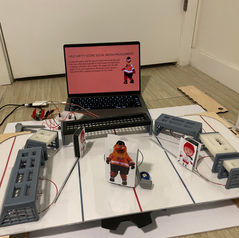Adina Weiss
Gritty vs. Social Media
Help Gritty Score Engagement on Social Media!
I don't watch hockey, but I do follow Gritty on Twitter. In my very biased opinion, he's the best mascot in the NHL. I thought it would be fun to take a closer look at his tweets. There were too many tweets to give proper attention to all of them, so this project focuses on the ones from 2023.

The objective of the game is to help Gritty score engagement on social media. His tweets have been broken down into six categories, each represented by a net. The bigger the net, the easier it is to score engagement. When you score a goal, a randomized tweet from that category will appear on the jumbotron.

Fabrication

I had so much fun with this project. I wasn't sure what to expect with an independent study since the one I took in undergrad was a very structured choral conducting independent study. With this one, I was able to tailor it completely to my interests, which was data physicalization. I came up with a few topic ideas and decided on analyzing Gritty's Twitter account. I started by transferring every tweet to an Excel sheet. There were too many tweets, so I only included tweets from 2023. I sorted tweets by like count, view count, retweet count, and quote tweet count to see what made a tweet popular. Then, I sorted the tweets into categories based on content. I ended up with six categories: Chaos, Pop Culture, Current Events, Holidays, Life Updates, and Work Updates. I took the average number of likes from each category and there was clear ranking of topics that were more likely to get more engagement. I decided to create a hockey game with different sized nets that would represent each category. Pop Culture had the highest like average, so that would get the biggest net. Work Updates had the lowest like average, so that would get the smallest net. I prototyped the rink using an old shoebox. I found a good puck option that was just under 1 inch. I wanted the net size to be proportional to the like average without having the nets too big. I decided to make the measurements 10, 6, 4, 3, 2, and 1 inches. This way, it's possible to score on the smallest net, but very hard. I modeled the nets in Fusion360, 3D printed them in 4 parts each, then assembled them all. I knew I wanted to have defenders moving to make it harder to score, so I 3D printed gears to sit on top of the motor. Since it's his Twitter account, it's only right that Gritty is the one on offense. I found the easiest way to handle Gritty was to have him stay in one location, and then spin in place to shoot the puck. I created the hockey rink in Illustrator and modeled the gear based on those sizes. I 3D printed the gear along with Gritty and the defenders. The defenders have a small rectangle cut out of the bottom so they can attack to the gear below the rink floor. Gritty's gear has a cylinder protruding through the floor. At first I shelled it as a circle, but I didn't want Gritty to spin unless the gear moved him. I undid the circle and negatively extruded a square. The Gritty model is the opposite, so there is a hollow circle with an interior square. This way, he is solid enough to spin and shoot the puck, but the user has complete control of his movements. I used a sheet of clear acrylic to look like ice. I tried to laser cut it, but the cuts didn't go all the way through the first time so we had to run it again. Next, I worked on the code to make the motors spin. After testing a lot of different numbers and snippets, I decided I liked having the defenders move in random increments. In order for the motors to be included, I knew the acrylic had to be raised. The sturdiest way to do this was to build supports out of wood. The IM laser was too small for me to do a single cut, so I split one piece into two. I also cut 4 corner pieces that had the same curvature as the acrylic to hold it in place in addition to elevating it. I glued everything together and it worked perfectly. I printed the rink design in three pieces, taped it together, then got it laminated. I printed pictures of Gritty and hockey player clipart then glued them to their blocks. Then I started assembling the whole project. I got a foam board to use as a base so I could easily hot glue parts to it so nothing would move. I glued one wooden support down, lined up the acrylic and the other wooden support, then glued the other wooden support down. I taped the rink design sheet to the clear acrylic sheet. I 3D printed little holders for both motors, so I lined up the motors with the gear track them glued the holders to the board. I made a support out of cardboard for Gritty's gear. I also shoved cardboard under the rink so the acrylic and laminated paper wouldn't sag.
Finished Project

Code

I liked this project because I finally got to use a motor. I used an adafruit circuit playground express board and edited the code in Mu. There are two motors each controlling a defender. My original plan was to have each defender move back and forth along the whole length of the track. The motors I got were not continuous motors, so I had to shift. Instead of moving continuously, the defenders now move random distances and random intervals. This actually works better since it makes it harder to time when you want to shoot the puck. The website ended up being much easier than I was expecting, thanks to help from Vini. The page goes to full screen when the space bar is pressed. I added in all the tweets that I had previously categorized. I wanted the tweets to automatically appear when a goal is scored, but I didn't get to that part. Instead, each category corresponds to a number. When a goal is scored, you press the number on the keyboard and a random tweet from that category will appear on the screen.
What Went Wrong/What I Learned
-
I knew that the hockey rink would be clear acrylic pretty early on. What I didn't take into account was the paper for the colored lines. I didn't think that a sheet of printer paper would be strong enough to hold all the 3D printed parts, so I laminated the paper. I tried to hot glue the 3D printed supports to the paper, but half of them fell off when I flipped it over. I tried super glue, but the pieces kept sliding around instead of adhering to the lamination. I tried a combination of super glue and hot glue to get the pieces to stay, and it held. Several hours later, I realized that was incredibly stupid, and I could just glue the player on top of the ice to the gear below the ice, and then it would still be able to move, but wouldn't need any supports.
-
The proportions of this project were difficult to manage with the equipment I had available to me. The IM laser wasn't big enough, so I had to go to Architecture. I almost cut the ice in three pieces, but I know it would look better in one piece. The paper with the rink design was printed in three pieces. I used to have access to a large format printer through work, but we switched buildings so I no longer have access to it. I asked a coworker if her husband could print it at his office, but their printer was down. I taped the sheets together and it looked okay, but it looks better now that it's laminated. Unfortunately, some dust got between the paper and the laminate before it was sealed, but it's not noticeable if you don't look too closely.
-
I never incorporated pressure sensors under the nets. This would have allowed the project to be self-sufficient. Now, I have to press a number every time a goal is scored. If I were to continue this project, that would definitely be the first step.
-
I thought the acrylic would be a little stronger. I made wooden supports for the far ends of the rink to hold the acrylic in place and suspend it so the motors could fit under and have room to work. I didn't expect the acrylic to sag in the middle. I cut some strips of cardboard and glued them to the foam board base to prop up the acrylic in the center. I also shoved some cardboard under the gear that controls Gritty. With more time, I'd make these supports out of stronger materials such as wood, acrylic, or PLA.
-
The gear that controls Gritty is huge because of the placement of Gritty. He easily could be moved two inches back, allowing the gear to be significantly smaller.
-
Measure twice, cut once!!!



































